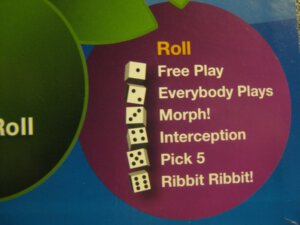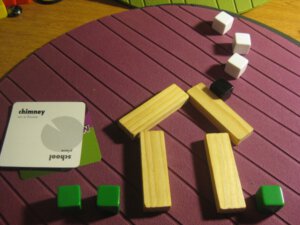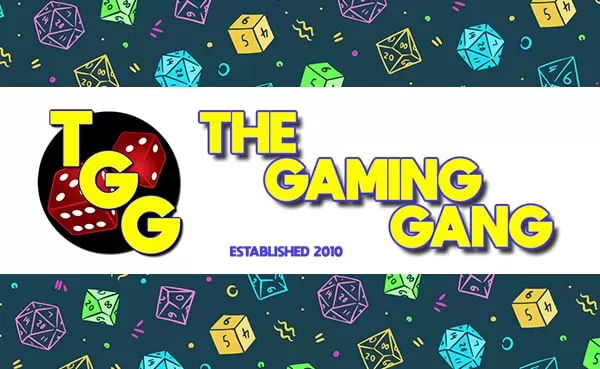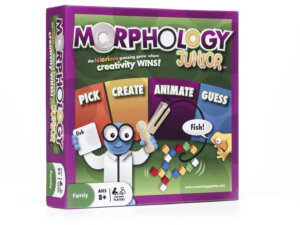Publisher: Morphology Games
Designer: Kate Ryan Reiling
Year: 2012
Players: 4+
Ages: 8+
Playing Time: 30 Minutes
Retail Price: $29.99
Category: Children/Family Game
Components:
- 6 wooden blocks
- 2 black circles
- 4 wooden people
- 1 string
- 1 piece of green felt
- 7 mana dice
- 12 glass beads
- 18 colored cubes
- 1 timer
- 4 team frogs
- 1 die
- Game board
- many word cards with easy/hard words
- rules
From Morphology Games
All the fun of the top selling Morphology Game for children 8 years and older. Children use their creativity designing the item on the card they choose and having others guess what it is. An easy to learn and fun game for 4 or more players.
Morphology Junior is the kid friendly version of the game Morphology, which are both produced by Morphology Games. The basic premise of both games is that a team or player selects a word from the stack of word cards, and then uses the various pieces included in the game to try to get your teammates to guess the word. If they do, you get to advance along the board toward the finish line. The first team to cross the finish line wins.
There are other rules. Some of the spaces on the board tell you to roll a die when you land on it, and the result will affect how you get to interact with the pieces when you are trying to get your teammaates to guess the word:
Roll a 1: Build using all of the pieces
Roll a 2: All of the teams get to guess, the first one to guess correctly gets to move their piece forward.
Roll a three: You get to use yourself as a piece along with the other pieces, like playing charades with props. Normally you can;t do this.
Roll a four: If your team cannot guess the word, the other teams get a chance to steal, kind of like on Family Feud.
Roll a five: You can only pick five pieces to use to create your word.
Roll a six: You can use the pieces, but this time you can make noises to help your teammates guess. So you can make animal sounds, or car sounds, or any sound you can think of, just no words.
The final space on the board is marked “5+1”, this means that your opponents get to pick five pieces that you can use, and then you get to pick one extra piece. You’re team will have to pass this challenge to advance and win the game. Also, there is a times which limits the amount of time your team has to guess the answer.
These rules are similar to the original Morphology, but a bit easier for the younger crowd. Additionally, the cards in this version have hints on them, so that you have some idea as to what the object relates to. They aren’t too obvious, but they do help. For example: the hint for “Mermaid” is “Person”.

The reason I wrote my review of the Junior edition of the game first is what really made me consider this game outstanding. It is recommended for ages 8 and up, but with a few simple rule tweaks I was able to play Morphology Junior with my just turned six year old daughter, and she has been asking me to play it again and again the past few weeks. In fact, when I brought it out to write this review she yelled “Yay!” because she thought we were going to play again. (It was bedtime, so we didn’t, but don’t worry we play a lot)
We played with just the two of us, me against her. I eliminated the die roll completely. We start on the first space of the board and move spot by spot. She will draw a card, and first she tries to read it herself. If she can’t she runs over and asks her mom or older brother (somebody not involved in the game at the time) to whisper it in her ear. Then she builds the word using whatever pieces she wants, and I try to guess. Sometimes she will give me a little hint by making a noise or motion with her hands. If I guess right, I get to move my frog piece (I forgot to mention that the playing pieces are all different colored frogs).
Then the roles are reversed. I do the same thing for her, again giving noise or motion hints when necessary. If she guesses right, she moves her frog. The first one of us to cross the finish line wins the game.
You would be amazed at the way playing like this stimulates her imagination. She will come up with pictures that to me might be almost incomprehensible, but once the word is revealed it makes perfect sense. Some of the easier words she can get me to guess right away without hints, and sometimes I don’t guess right at all. I usually end up losing because it is easier for her to guess mine than me to guess hers, but that doesn’t matter at all. This game is really bringing out her creative side, helping her to practice her reading, and she is having a lot of fun. She could care less if she wins or loses, as long as we get to play the game again.
Sometimes it can get really abstract on me, but it’s great to see how her mind is working. One time she had the word “Napkin”, so she took a single white cube and placed it on the table in front of me. As you could imagine I laughed and said, “What, that’s it?” She nodded sagely and wouldn’t give me any hints because she figured it was so easy. I tried my best, guessing “sugar cube” and the like, to no avail. Once she told me, I saw it right away and we both laughed.
A few turns later she had “Dinner”. She made a fork, plate with food on it, and the single white cube next to it. I was baffled again 
Playing it this way, it was a lot of fun and you should see how much better she has become at making her words in the game. She just loves playing with the different pieces too.
Playing Morphology Junior with its intended audience is a fun way to spend some quality family time together. It’s similar to other games of its type, and thus earns an ok rating from me. However playing it with the 5-7 year old group with the rule changes presented above really takes this game up a few notches and I highly recommend it. I’m in no way a child psychologist, but I believe this game would also benefit some children with development disorders, depending upon the type and severity of the disorder.
- A Dungeon Delve for Kids?: A Review of Dungeon! - Oct 24, 2022
- Better, Stronger, Faster | Descent: Journeys in the Dark Second Edition Reviewed - Oct 23, 2022
- Your Planet is Doomed!: Invasion from Outer Space Reviewed - Oct 22, 2022













